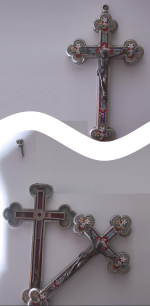Reliquary Cross

Reliquary Cross (14 cm x 8 cm)
The pin at the top is unscrewed to enable the cross to swing open and reveal the relic inside
Click photo for more, full-size images
(pdf file 901kb)
Fake relics can be bought for a few dollars at many emporiums, with a note that it has the power to perform miracles. The note will be either a subtle hint or an iron-clad guarantee, depending on the local laws regarding misrepresentation of goods.
A genuine Relic Cross is made from, or contains a fragment of, the True Cross. Obviously there are not many of those around; if any!
A geniune Reliquary Cross is also rare. They contain relics of deceased saints - a lock of hair for example, fragments of clothing or some other items that belonged to a saint.
More common is a cross that contains an item that was at some time handled by a particular holy person (the pope, for example), or just about anything tangible that has had deep religious significance.
Several miracles have been attributed to these (officially and unofficially) and so they are venerated, particularly by Catholic, Orthodox and Anglican Christians.
The one shown on the right was given to a nun in the Vatican in the early part of the 20th century. The present owner, the great-great-nephew of the nun, has been told the fragment of red cloth inside the cross is from the pope's vestments.
An expert in Roman Catholic ecclesiastical matters, Sean Wright, advises that the pope's vestments are predominantly white, so this fragment might have been from the red fascia he wore during his days as a cardinal. Alternatively, it could be from the pope's red travelling cloak or from a part of the underside of one of the lappets which fall behind a mitre.
The Roman Catholic Church classifies relics as:
| 1st Class | Items directly associated with the events of Jesus Christ (the True Cross, for example), or the physical body part of a deceased martyr or saint (skull or other bone, tooth, hair, etc.) |
| 2nd Class | Clothing worn by a saint or some other personal possession (cross, book, chair, etc.) |
| 3rd Class | An item that has been touched to a 1st or 2nd Class relic |
In churches and cathedrals, small relics are often housed in Reliquary Crosses and kept in a secure place, being brought out on special occasions only; for example as part of an exorcism rite.
Relics may also be housed in a device similar in appearance to an altar cross or monstrance, but locked away safely in a shrine rather than displayed on an open altar table. The example shown at the top of this page on the left, is available from McKay Church Goods https://www.mckaychurchgoods.com/reliquary.htm – empty, of course.
